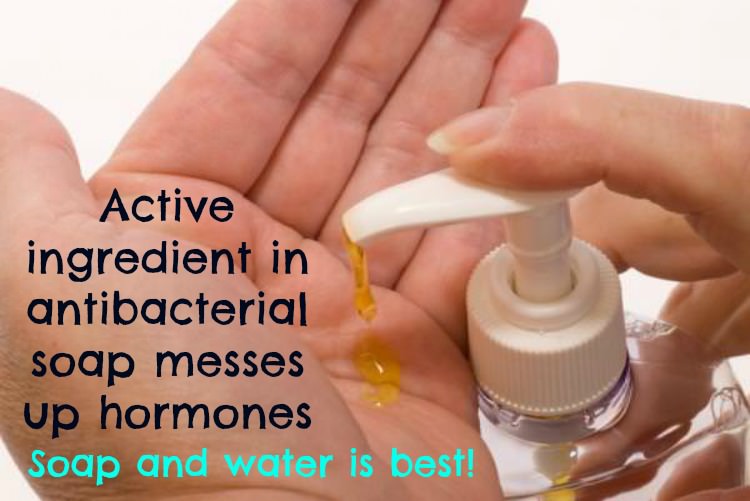
Over a decade ago, antibacterial soap became all the rage and suddenly every public bathroom and every home seemed to be stocked with it.
This rapid switch away from plain soap and water occurred despite the fact that there was and still is absolutely no evidence that antibacterial soap works any better than the traditional suds it up approach.
Fast forward to today and fully 75% of liquid soaps on the market still use antibacterial ingredients despite increasingly loud warnings about their safety and efficacy.
Antibacterial Soap = Disrupted Hormones
The reason for much of the concern is the use of triclosan, the active ingredient in many antibacterial products. This chlorinated phenolic compound has been linked to disrupted hormonal activity in animals.
Estrogen dominance is a big contributor to the irritating and sometimes debilitating symptoms of perimenopause. Avoiding any chemicals that produce the tendency toward estrogen dominance is vital for every woman over 40 if she desires a symptom free transition to menopause. It is also very possible that widespread use of this chemical (along with others like BPA) is a factor in the early puberty experienced by so many young girls today. In boys, estrogen mimickers produce the opposite effect.
Obese boys, in particular, are at risk for delayed puberty, likely due to the estrogenic effects of the extra fat they are carrying combined with environmental exposure to estrogen mimickers like triclosan. Exposure to this chemical clearly has risks for anyone no matter what his/her age. Another disturbing finding is that triclosan has been shown to reduce circulating thyroxine (T4 – thyroid hormone) in rats.
Lack of sufficient circulating thyroid hormone produces the symptoms of hypothyroidism, currently at epidemic proportions in the Western world. You know the symptoms of hypothyroidism well – fatigue, thinning hair, depression, cold hands and feet, and difficulty losing weight.
Chances are you or someone in your household already suffers from it even if not yet diagnosed by a physician. Watch out, as triclosan is used not only in soap, but also detergents, cosmetics, deoderant, toothpaste, children’s clothing, and even toys. I remember the tray of the Playskool highchair I used when my children were very young was stamped as “antibacterial”. Probably triclosan was used in this item as well!
I am very careful never to buy any products that are marketed as “antibacterial”.
Antibacterial Soap Contributes to Antibiotic Resistance and Superbugs
As if this wasn’t enough, use of antibacterial soaps is now being linked with antibiotic resistance and the spread of superbugs. When you use bleach, soap, peroxide or alcohol to clean and disinfect, germs are destroyed or dislodged and washed away. Germs have no power against this approach and cannot ever develop resistance to it. Antibacterials like triclosan work very differently by interfering with a bacterial enzyme through penetration of the bacterial wall. Through their ability to evolve very quickly, microbes have the potential to develop enzyme systems that are resistant to triclosan over time. One popular tuberculosis antibiotic targets the exact same bacterial enzyme system as triclosan.
There are now two strains of TB that are resistant to two or three of the four first-line antibiotics! Coincidence? Possibly, but the likelihood that there is a link is clearly there. This is a scary scenario indeed.
Plain Soap and Water is Still the Best!
As mentioned earlier, there is absolutely no evidence that use of antibacterial soap works any better than plain old soap and water. In fact, there is plenty of reason to believe that soap and water is a far superior method for hand washing and cleaning in general given the resistance that germs are suspected to be developing to antibacterial compounds like triclosan. Factor in the risk of hormone disruption from using these antibacterial products around your home and the wise move seems to be to throw them out altogether!
If you are looking for an excellent quality, nontoxic concentrated soap to dilute with water to economically fill all the hand soap dispensers around your home or office, I would highly recommend this brand.
Sarah, The Healthy Home Economist
Sources and More Information
Doctor’s Group Questions Antibacterial Soaps
Triclosan Exposure Reduces Circulating Thyroxine in Rat Fetuses
Triclosan Exposure Reduce Thyroxine Levels in Pregnant and Lactating Rats








When you are using Dr. Bronners how many squirts do you use for a typical hand soap dispenser?
That was great.Thank you
good article thank you. be aware 1 of the ingredients on the Dr Bronners label, citric acid, is not listed on the amazon web page. there are castile soaps with no citric acid